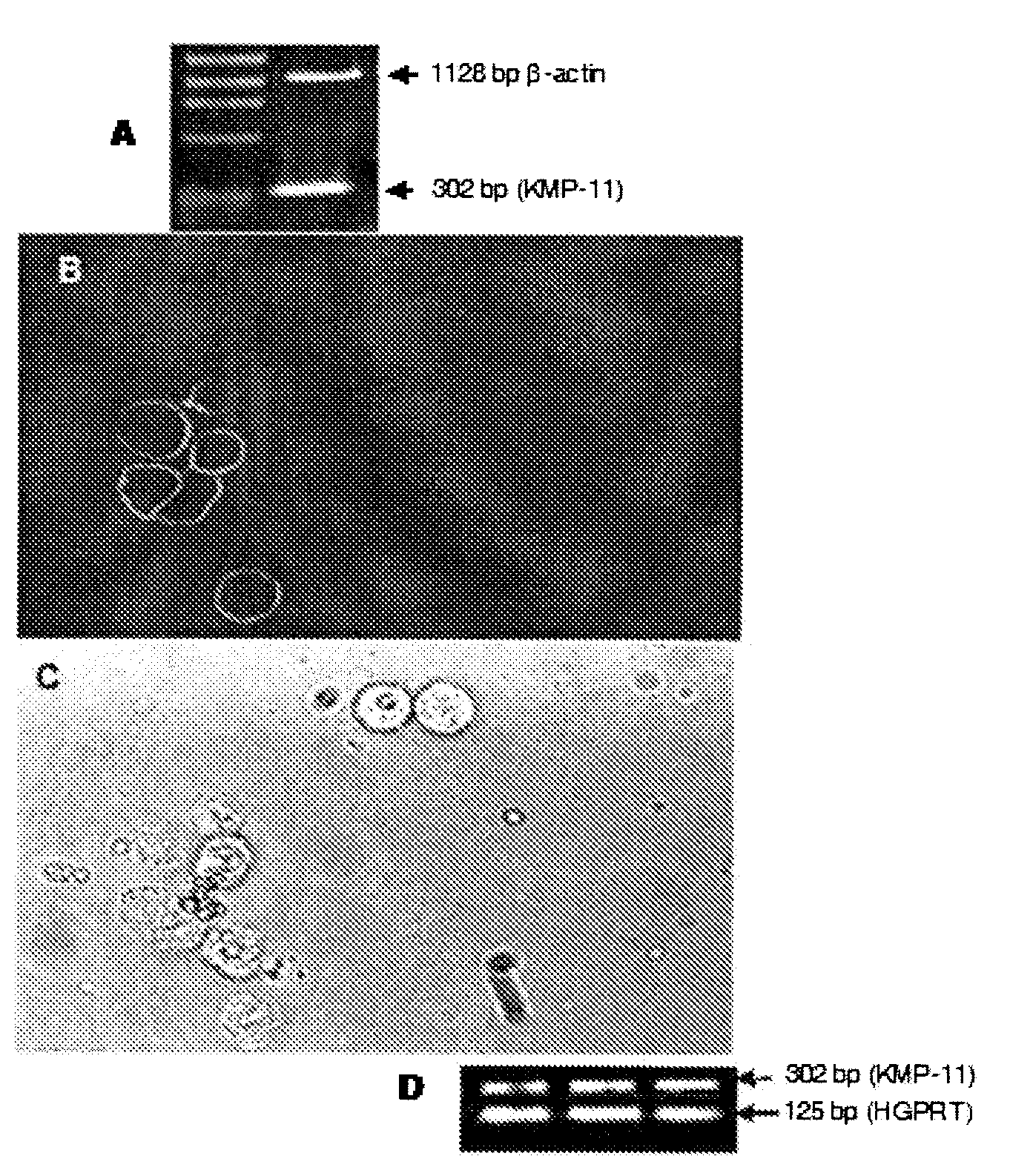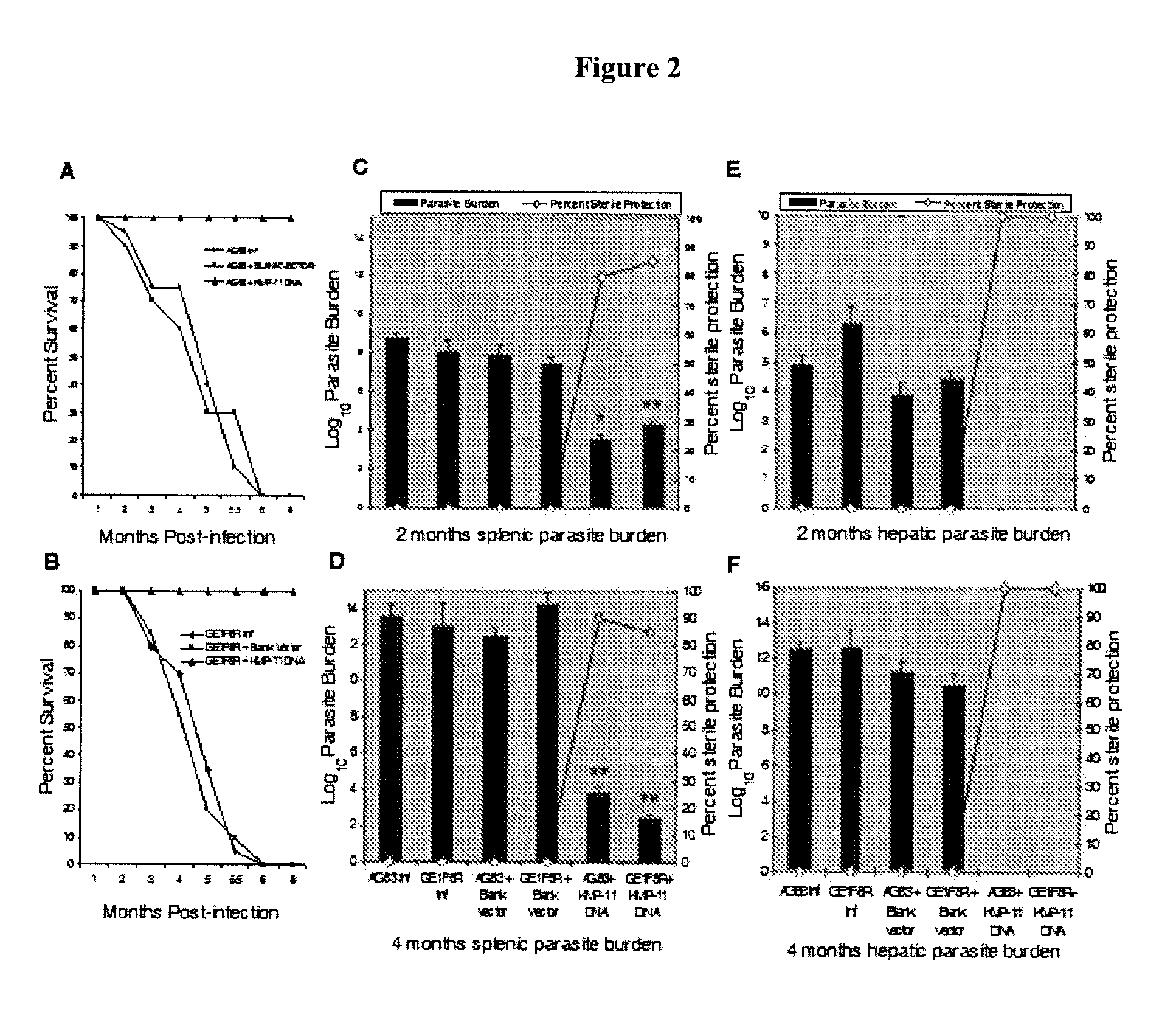DNA vaccine as immunoprophylaxis against kala-azar
a technology of immunoprophylaxis and dna vaccine, which is applied in the direction of dna/rna vaccination, genetic material ingredients, antibody medical ingredients, etc., can solve the problems of antimony no longer being useful as a drug, frequent relapse after treatment, and more than 100000 deaths, so as to reduce the burden of splenic and liver parasites, eliminate the parasite from the mammal, and reduce the burden of splenic and liver parasi
- Summary
- Abstract
- Description
- Claims
- Application Information
AI Technical Summary
Benefits of technology
Problems solved by technology
Method used
Image
Examples
example 1
Preparation of DNA Vaccine Construct
[0030]108 promastigotes washed with PBS, pH 7.4, (1.37 mM NaCl, 2.7 mM KCl, 4.3 mM Na2HPO4, 1.47 mM KH2PO4) and STE (10 mM Tris-HCl, pH 7.5, 100 mM NaCl, 1 mM EDTA) were suspended in STE buffer and incubated with Proteinase K (1 mg / ml) (Invitrogen, Grand Island, N.Y.), 0.5% SDS at 50° C. for 4 h. Nucleic acids were extracted by phenol: chloroform: isoamyl alcohol extraction and ethanol precipitation. Genomic DNA was spooled, and subjected to RNase (100 μg / ml) treatment. Genomic DNA from muscles was extracted as described previously Xu, D., and F. Y. Liew. 1995. Protection against leishmaniasis by injection of DNA encoding a major surface glycoprotein, gp63, of L. major. Immunology 84:173. Whole DNA from all tissues was extracted with Extraction Buffer (10 mM Tris pH 8.0, 0.1 M EDTA, 20 μg / ml pancreatic RNase, 0.5% SDS and 100 μg / ml Proteinase K) followed by phenol: chloroform: isoamyl alcohol extraction and ethanol precipitation method. All the PC...
example 2
Verification of DNA Vaccine encoding antigen expression by transfection
[0033]Transfection of Hep2 cell line and normal splenic macrophages derived from golden hamsters were done with pCMV-LIC KMP-11 construct. One day before addition of DNA, 0.9×105 cells per well in 5 ml RPMI 1640 were incubated under normal growth conditions (37° C. and 5% CO2 supply) till the culture was 40% confluent at the time of DNA addition. 0.5 μg of plasmid DNA diluted in DNA Condensation Buffer was mixed with required amount of Enhancer solution according to manufacturer's instruction (Qiagen, GmbH, Hilden, Germany). Cells along with plasmid DNA were incubated at 37° C. in 5% CO2 incubator for 36 h for expression of transfected gene. Two sets of experiment were performed as controls, in one of which the transfection was done with blank-vector (pCMV-LIC) and the other without addition of plasmid DNA.
example 3
RNA Isolation & RT-PCR from KMP-11 DNA Transfected Hep2 Cells
[0034]Total cellular RNA was extracted from 5×106 Hep2 cells by RNeasy Minikit (Qiagen GmbH, Hilden, Germany) and treated with DNase 1 (Amplification Grade, Invitrogen, Grand Island, N.Y.). RT-PCR was carried out on 500 ng RNA by using Platinum Quantitative RT-PCR Thermoscript One-Step System (Invitrogen, Grand Island, N.Y.) with KMP-11 gene-specific primers: forward primer 5′-ATGGCCACCACGTACGAGGAG-3′; and reverse primer 5′-TTACTTGGACGGGTACTGGGC-3′ at the following conditions: 50° C. for 20 min for cDNA synthesis and with initial denaturation at 94° C. for 5 min followed by 35 cycles of denaturation at 94° C. for 30 s, primer annealing at 60° C. for 30 s, and extension at 72° C. for 30 s for PCR in a final volume of 50 μl for amplification of KMP-11 gene (Gene Amp® PCR System 9700 DNA Thermocycler). Amplification of β-actin transcripts as house-keeping control was determined for every PCR sample by amplification with prime...
PUM
| Property | Measurement | Unit |
|---|---|---|
| Immunogenicity | aaaaa | aaaaa |
| Cytotoxicity | aaaaa | aaaaa |
Abstract
Description
Claims
Application Information
 Login to View More
Login to View More - R&D
- Intellectual Property
- Life Sciences
- Materials
- Tech Scout
- Unparalleled Data Quality
- Higher Quality Content
- 60% Fewer Hallucinations
Browse by: Latest US Patents, China's latest patents, Technical Efficacy Thesaurus, Application Domain, Technology Topic, Popular Technical Reports.
© 2025 PatSnap. All rights reserved.Legal|Privacy policy|Modern Slavery Act Transparency Statement|Sitemap|About US| Contact US: help@patsnap.com



